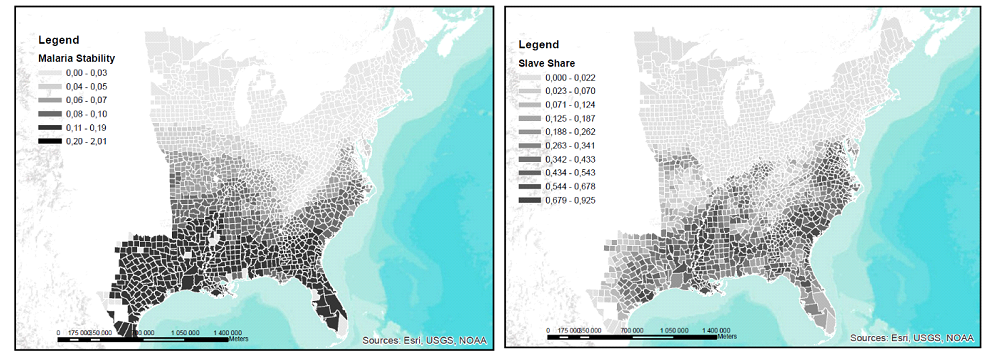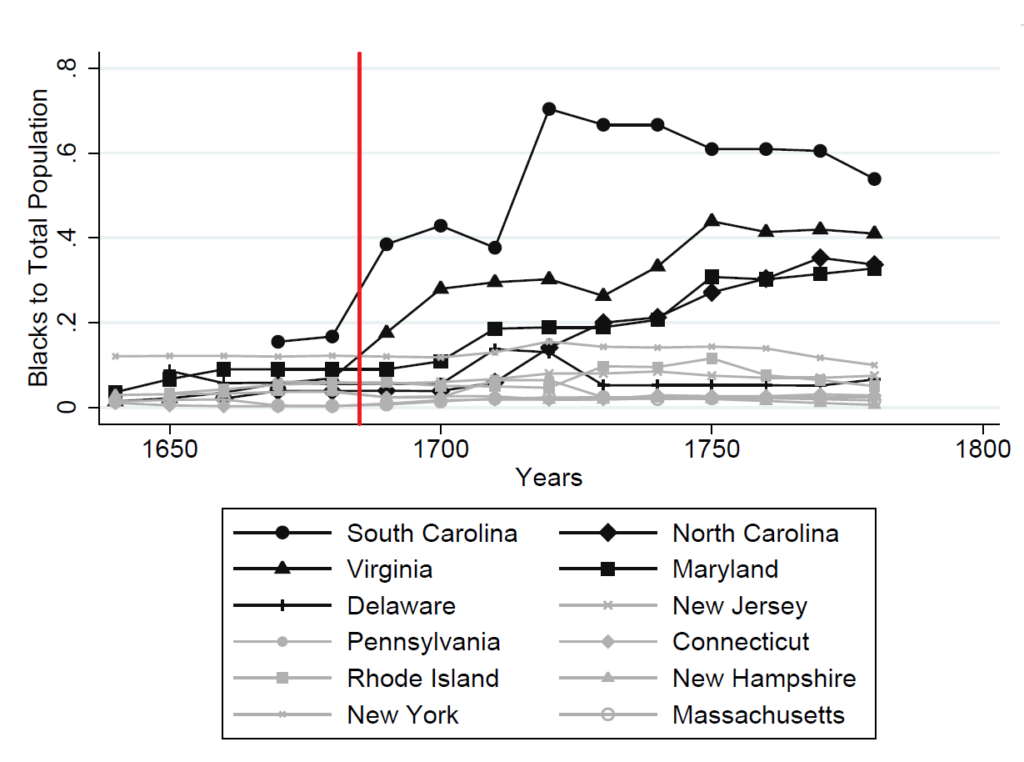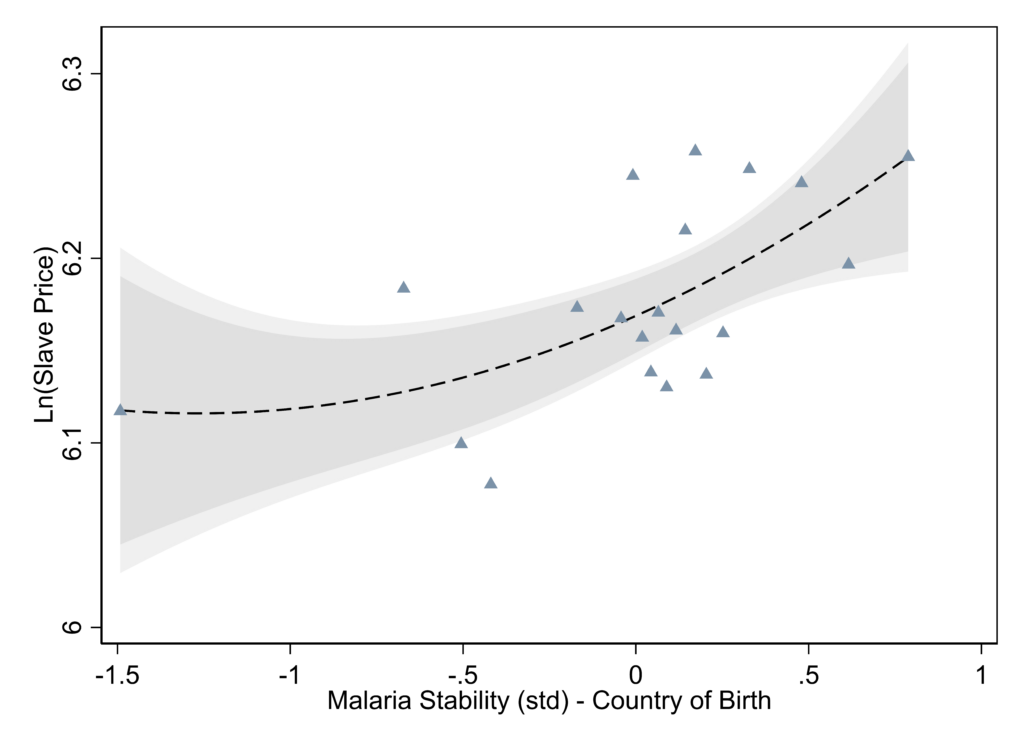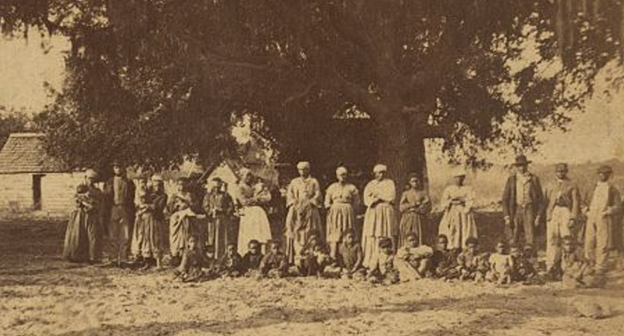Why slavery was practised in certain US regions and not in others and why specific groups of Africans were transported in such great numbers to the New World is both a historically fundamental and economically relevant question. It has been shown that African slavery sowed seeds of deep political and economic inequalities that persist to this day (Engerman and Sokoloff, 1997). Slavery also hindered the long-term growth prospects of African populations subjected to slave raids and enslavement, fostering fractionalization and distrust (Nunn, 2007; Nunn and Wantchekon, 2011). Several historians, including Curtin (1968) and McNeill (2010), have hypothesized the role of tropical diseases in the deployment of the Atlantic slave system and its impact on the Americas. The fundamental challenges in empirically evaluating this hypothesis lie in the complexity of disentangling the geography of crops from the geography of diseases. Additionally, considering the multitude of other concurrent cultural and institutional drivers, the role of diseases in the spread of African slavery remains a subject of debate.
In a recent study (Esposito, 2022), novel empirical evidence illuminates the role of tropical diseases, particularly malaria, in the spread of African slavery in the United States. The study reveals that there was a heightened demand for labor wherever malaria thrived, especially labor resistant to malaria. In such regions, the malaria resistance exhibited by sub-Saharan Africans increased the profitability of employing African labor. Consequently, the geography of malaria partly helps elucidate why African slavery proliferated more in specific areas of the United States than in others and why individuals from certain African regions were extensively employed in these regions. It is important to note, however, that the increased demand for malaria-resistant labor did not necessarily mandate the establishment of a system of labor coercion. The moral and political feasibility of such a system falls outside the scope of this work.
Slavery and malaria suitability across the U.S States
The study first establishes a strong correlation between the prevalence of slavery and the local geographical suitability for malaria across U.S. states. The local malaria suitability is predicted using epidemiological models based on the geographic features of each location. The spatial correspondence between slavery and malaria suitability is visually evident in the maps presented in Figure 1.
Figure 1: Malaria Stability and Share of Slaves across US counties in 1860

Interestingly, the study also reveals that areas more affected by malaria were prone to developing stronger proslavery views. In particular, an exploration of delegate votes at the Constitutional Convention of 1878 uncovers that delegates born in counties with a higher risk of malaria tended to be more supportive of proslavery stances. Furthermore, counties with greater malaria suitability were less likely to vote for candidates who opposed slavery and advocated for Black enfranchisement before the Civil War and during the early Reconstruction Era.
The patterns of slavery before and after the arrival of falciparum malaria
To move beyond correlational evidence, we delve into the historical period surrounding the introduction of malaria to the United States. Specifically, we focus on a significant and swift intensification of malaria incidence that occurred following the introduction of falciparum malaria, recognized as the most deadly and virulent among malaria species. In the difference-in-difference exercise, we examine the increase in the share of African slaves that followed the introduction of falciparum malaria, comparing the states that were more suitable for malaria with less suitable states.
The analytical intuition can be gleaned from the evidence presented in Figure 2. Malaria falciparum made its initial appearance in the United States around 1690. Given that different states exhibit varying levels of malaria suitability, they also possess distinct probabilities for the disease to become endemic in their territories. In the graph, the grey bars represent the share of slaves in the population over time. Colonial states with malaria suitability below the average are colored in grey, while those with malaria suitability above the average are colored in black. The figure depicts that before 1690, all states exhibited comparable low levels of slaves in their populations. However, as indicated in the illustration, following the emergence of malaria falciparum, the proportion of slaves markedly rises only in colonial states with a higher geographical suitability to the disease. The implicit suggestion is that the states more conducive to malaria would have mirrored the trends observed in other states if falciparum had not been introduced into the country.
Figure 2: Share of Slaves across the US Colonial States before and after the arrival of Malaria Falciparum in areas with high (black) and low (grey) malaria suitability.

Finally, we shed light on the underlying economic motives behind the previously discussed macro phenomena. On the one hand, malaria contributed to the scarcity of free labor. On the other hand, the disease made malaria-resistant workers comparatively more productive, leading slave owners to shift their labor demands toward African workers, especially those from regions with higher malaria prevalence.
Epidemiological studies indicate that malaria resistance is more prevalent in African regions that are historically most exposed to the disease. Utilizing historical data from the Louisiana Slave Records 1719–1820 database, we demonstrate that among African slaves born in Africa, individuals with higher malaria resistance—those born in the most malaria-ridden regions of Africa—commanded significantly higher prices. The binned scatter plot in Figure 3 visually depicts the correlation between malaria prevalence in the African country of birth and the average price of the individual on the Louisiana plantations while accounting for a host of geographical and locational controls.
Figure 3: Malaria Stability in the African country of Birth and price in the Louisiana Plantations

Conclusion
The presented evidence documents the role of diseases, notably malaria, in the diffusion of African slavery in the Southern United States. The study reveals crucial economic motives influenced by the geography of malaria. It is evident that, in the establishment of African slavery in the American South, these underlying economic factors intersected with the cultural and political dynamics of the Atlantic World during a period when forced enslavement was considered a politically and morally acceptable option. Although this paper does not focus on the cultural and political context that allowed slavery to persist as a labor and social organization system, it illustrates that the geography of malaria, influencing the economic viability of African slave labor, interacted with that context and played a role in shaping it.
References
Curtin, P. D. (1968). Epidemiology and the slave trade. Political Science Quarterly 83(2): 190-216.
Engerman, S., & Sokoloff, K. (1997). Factor Endowments, Institutions, and Differential Growth Paths among New World Economies in S. Haber. How Latin America Fell Behind. Stanford, CA: Stanford University Press.
McNeill, J. R. (2010). Mosquito empires: ecology and war in the Greater Caribbean, 1620-1914. Cambridge University Press.
Nunn, N. (2008). The long-term effects of Africa’s slave trades. The Quarterly Journal of Economics 123(1): 139-176.
Nunn, N., & Wantchekon, L. (2011). The slave trade and the origins of mistrust in Africa. American Economic Review 101(7): 3221-3252.
Feature image: African American slave families (Free access at: https://picryl.com/media/african-american-slave-families-owned-by-mrs-barnwell)
